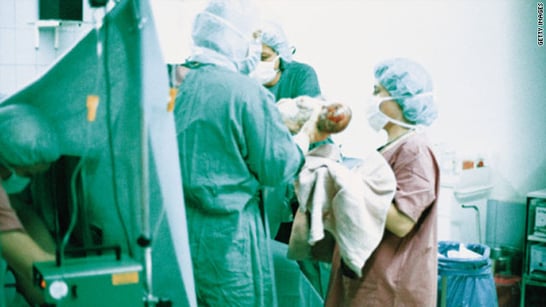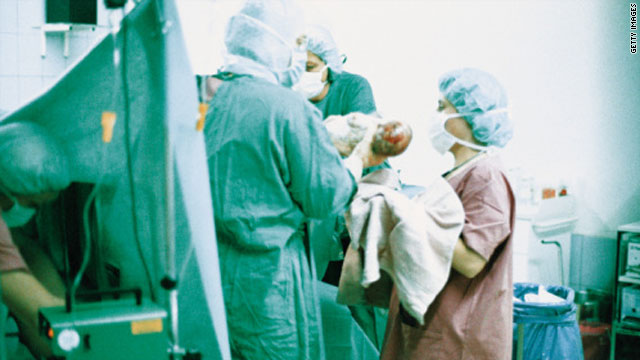 In this day and age, you probably think women don’t die in childbirth, and if they do, it must be an extremely rare occasion or in 3rdworld countries – right? No, it’s happening right here in the US. Find out why and what you can do to help these numbers go down.
In this day and age, you probably think women don’t die in childbirth, and if they do, it must be an extremely rare occasion or in 3rdworld countries – right? No, it’s happening right here in the US. Find out why and what you can do to help these numbers go down.
More women are dying in childbirth in the US than in any other developed country. And experts say the problem is likely to keep getting worse.
You can see how alarming the issue is in this chart. In other countries, maternal death rates have fallen sharply since 1990. In South Korea, the rate of women dying in childbirth fell from 20.7 deaths per 100,000 live births in 1990 to 12 today. In Germany, it dropped from 18 to 6.5.
But in the United States, the opposite is happening. The rate of women dying in childbirth is going up.
This wasn’t supposed to happen. During the 20th century, the maternal death rate in the  United States dropped from 607.9 deaths per 100,000 births in 1915 to 7.2 in 1987. But over the past 30 years, the maternal mortality rate trend reversed and steadily marched upward.
United States dropped from 607.9 deaths per 100,000 births in 1915 to 7.2 in 1987. But over the past 30 years, the maternal mortality rate trend reversed and steadily marched upward.
Pregnancy-related deaths are still rare events in the US; only about 700 women die out of 4 million live births annually. But the US is one of the few rich countries in the world where maternal mortality is steadily rising. The maternal mortality rate has more than doubled since 1987, the first year the Centers for Disease Control and Prevention began collecting data through its pregnancy mortality surveillance system.
And experts are just now understanding why this is happening — why the United States looks so different from other countries, and why so many more new mothers are dying. They think maternal deaths are rising because of the rising toll of chronic diseases.
Thirty years ago, women died in the delivery room because of hemorrhages and pregnancy-induced blood pressure spikes. Now they are much more likely to die because of preexisting chronic conditions like heart disease or diabetes.
"We’ve seen a big bump in cardiovascular disease and chronic disease contributing to maternal deaths," said Dr. William Callaghan, chief of maternal and infant health at the CDC. "Underlying heart disease is common, diabetes is common. We now have a group of women bringing with them into pregnancy their entire health history."
Cardiovascular diseases are now the second leading cause of pregnancy-related deaths in the US
Thirty years ago, almost a third of all pregnancy-related deaths were because of hemorrhages — or women bleeding to death.
But today that number has dropped by nearly a third. Hemorrhages now account for 11.4 percent of pregnancy-related deaths. Deaths related to embolisms and pregnancy-related hypertension disorders have also steadily declined. And deaths due to anesthesia complications have almost entirely disappeared.
Instead, more women are dying from pregnancy complications related to preexisting chronic diseases — in particular, cardiovascular diseases.
Cardiovascular conditions are now the second leading cause of pregnancy-related deaths, falling right behind non-cardiovascular diseases. And when combined with cardiomyopathy (diseases related to weakened heart muscle tissue) cardiovascular disorders make up more than a quarter of all pregnancy-related deaths.
Thirty years ago, cardiovascular diseases accounted for less than 10 percent of all pregnancy-related deaths, but as of 1998 to 2005, CDC researchers noted their increased prevalence as a leading cause of death.
Part of the uptick in cardiovascular-related deaths is because more pregnant women in the US have chronic health conditions such as hypertension, diabetes, and obesity, all of which put them at a much greater risk for pregnancy complications.
"It’s a larger problem than just dealing with women during pregnancy, it’s the health of our society," said Callaghan. "Imagine a [pregnant] woman comes in with BMI of 40, and she’s 24 years old — that didn’t happen in the past year, it happened in the past 24 years."
The number of pregnancy deaths caused by infections has, meanwhile, held relatively steady — not a building problem, but an indication of how the American health care system struggles to protect patients from risks once they enter the hospital.
Age doesn’t explain why maternal deaths are increasing
More than a quarter of all pregnancy-related deaths in the US involved women 35 and older. This is a substantial improvement from previous years, when the percentage topped 50 percent.
The risk of dying from pregnancy complications increases with age for women of all races and ethnicities. But experts don’t think older women having children in the US explains the upward trend of the maternal death rate.
"Pregnancy is riskier the older you get and the risk increases exponentially past the age of 35," said Nicholas Kassebaum, assistant professor at the Institute for Health Metrics and Evaluation. "But the number of women who have delayed pregnancy in the US has not gone up more than in other high-income places."
Black women still experience the greatest risk of dying from pregnancy complications
One stark — and somewhat inexplicable — trend in pregnancy-related deaths is that black women are significantly more likely to die than their peers.
Studies have shown that black women are less likely to begin prenatal care in the first trimester and are more likely to have preexisting chronic conditions such as hypertension,diabetes, or obesity than white women. But this still doesn’t account for the enormity of the disparity that currently exists.
Black women are two to three times more likely to die from pregnancy complications than white women. What’s more, researchers found this to be true regardless of age, education, or similarities in living conditions.
And the disparity is growing worse. The maternal death rate for black women rose from 34 percent in 2007 to 42.8 percent in 2011. During the same time period, the maternal death rate for white women only increased by 0.7 percentage points.
Sadly, this finding is not all that surprising. Black people, and in particular black women, are significantly more likely to die from a health condition than their white peers. But according to Dr. Callaghan, the differences in the maternal death rates for white and black women are currently the most severe disparity in US health care.
"It’s the thing that wakes us up in the middle of the night as we try to understand it," said Callaghan. "It’s access issues, differences in care based on geography, differences in health status — it’s all these things … and we’re not going to find the one thing that causes it."
Lots of maternal deaths are preventable. But we don’t have the right public infrastructure in place.
We know that maternal mortality is a big problem in the United States. But one of the most vexing issues researchers face is the absence of reliable data. Some states have maternal death review boards to collect data. But other states don’t. And what the boards do can vary tremendously from state to state, leaving public health researchers with an incomplete view of the problem.
And it's especially important to study pregnancy-related deaths because the best research we have suggests as many as one in three were preventable. So public health officials are now working on a national initiative to review every single pregnancy-related death in America — and the movement is building momentum.
In 2012, the CDC partnered with the Association of Maternal & Child Health Programs (AMCHP), a public health advocacy group, to help create state-level review boards to assess maternal deaths in every single state.
When they started, there were only 18 states with active review boards, but by 2016 at least 39 states had review boards either active or in the works.
How it works is simple: A board of medical experts in each state meets and reviews information on every single maternal death in that state, looking at potential issues ranging from prenatal care to the role preexisting health conditions played.
The idea is that by determining the causes of each maternal death, trends will emerge, which in turn will help doctors and health care providers identify how to best prevent maternal deaths.
In my interview with Dr. Callaghan, he credited the drop in pregnancy-related deaths caused by hemorrhage and pregnancy-induced hypertension to improved medical interventions. Doctors began to use oxytocin to stimulate uterine contractions in the case of hemorrhage and more regular prenatal blood pressure checks to assess risk of hypertension. They learned from what went wrong in previous cases, and worked to prevent those situations.
So Callaghan is hopeful the same success can be replicated for treating and managing more troubling complications, such as cardiovascular diseases, by studying the causes of maternal deaths on a case-by-case basis.
The CDC and AMCHP are analyzing the data collected by the individual review boards. The current plan is to establish an active review board in all 50 states, and produce a national report so that lessons can be more readily shared between states and health care providers.







